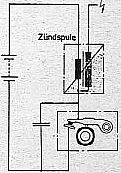

The 2CV has a conventional ignition controlled by a breaker. This is the simpliest kind of igniton. A better model is a transistor-ignition. The current of the coil is switched by a transistor and not by the breaker. That gives the breaker a much longer live. Beside these two types there are two other systems: the magnetic-ignition and the Tyristor-ignition, but they are not important for us. (The pic on the right is not a 2cv ignition. But it is the same system) |
 |
The way it works:
The two most important parts (apart from the spark-plugs and the
cables and all the other stuff around the ignition) is the ignitioncoil and the breaker.
The primary side of the coil is linked with the positive pole of the car batterie
(Of course switched on and off by
the ignition key). The negative pole is turned on an off by the breaker. When the breaker
is closed an electric current flows from the positive pole through the coil to the breaker
back to the batterie (negative pole). This current establishes a magnetic field in the
primary side of the coil. In the moment the ignition shell happen the breaker opens and
the current through the coil is stopped. The collapsing magnetic field is inducing a very
high voltage in the secondary side of the ignitioncoil. This very high voltage (more than
10.000 volt) causes the spark at the sparkplug.
Remember your physics leasons at school: If an electronic conductor is crossing a magnetic
field then a voltage gets induced.
The condensor which is parallel connected to the breaker speeds up the crash of the
primary magnetic field when the breaker opens. It also prevents that the breaker burns out
to fast.
When the breaker closes it takes some time until the coil reaches its maximum magnetic
field. Because of this you need a minimum time in which the breaker
has to be closed. (see dwell angle).
Copyright © C-LAUS TECHNOLOGY .
All rights reserved
May 29th. 1999